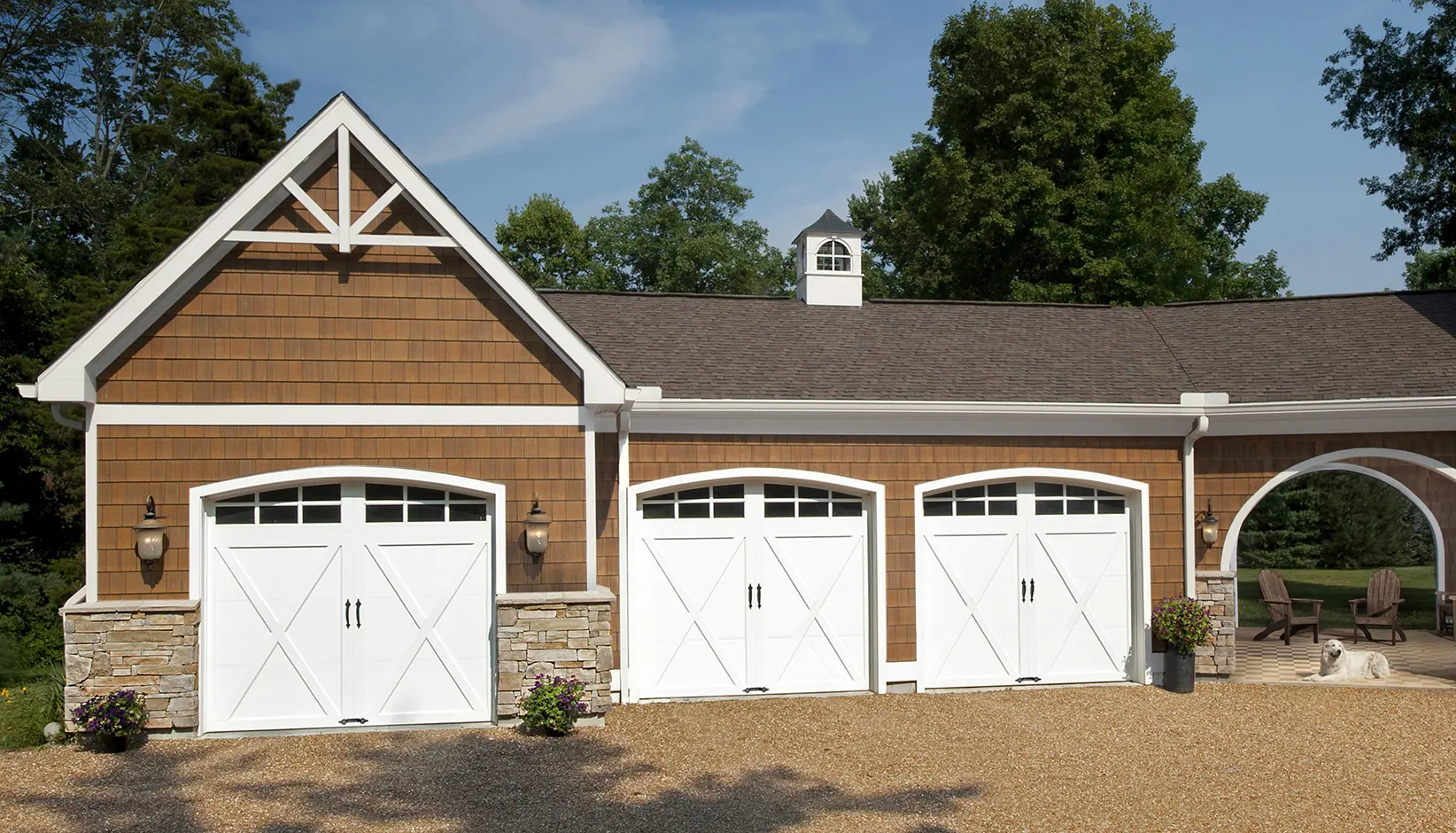Regular garage door inspections prevent unexpected failures, enhance safety, and extend system lifespan. This detailed quarterly checklist explains each item’s purpose, inspection method, and corrective actions. Follow every three months to keep your garage door operating at peak performance.
1. Visual and Structural Inspection
Begin by surveying the entire door to detect signs of physical damage or misalignment that compromise operation and weather resistance.
Door Panels:
– Inspect each panel for dents, cracks, rust spots, or wood rot. Even small surface dents can collect moisture and lead to corrosion or wood decay.
– Check panel alignment: when fully closed, horizontal seams should line up evenly without center sag or edge gaps exceeding ⅛ inch. Misalignment signals structural or track issues.
– Corrective action: minor dents can often be popped out with gentle tapping from inside (if accessible). Rust spots require cleaning with wire brush, rust inhibitor, and touch-up paint; wood rot requires replacement of affected sections.
Tracks and Rollers:
– Examine tracks along both sides for bends, kinks, or gaps between roller wheels and the track’s metal rail. Debris buildup (dirt, gravel, leaves) often causes binding or skips.
– Rollers should spin freely without wobbling. Corroded or seized rollers increase friction and noise, causing stress on springs and opener.
– Corrective action: clean tracks with a cloth and mild detergent; do NOT lubricate tracks. Replace bent tracks professionally and swap out damaged rollers (nylon rollers with sealed bearings preferred for quiet operation).
Weatherstripping:
– Check the bottom rubber seal and side/top vinyl or rubber gaskets for cracks, brittleness, or separation from the door. Gaps allow air, water, pests, and dust into the garage.
– Press fingertips along seals to verify compression and rebound; seals should spring back fully.
– Corrective action: replace worn seals with matching profiles; ensure proper seal height for uneven driveways by trimming or adding threshold seals.
Hinges and Brackets:
– Inspect all panel-to-panel hinges and track mounting brackets for loose, missing, or corroded fasteners. Shaking the door gently should not reveal play at connection points.
– Rust or metal fatigue at brackets can fail under load, causing panels to collapse.
– Corrective action: tighten fasteners to manufacturer torque specifications and replace any corroded or cracked hinges/brackets immediately.
2. Mechanical Components
Mechanical parts bear the most stress. Proper condition prevents sudden failures and ensures balanced operation.
Springs:
– Torsion springs above the door or extension springs alongside tracks must be inspected for gaps in coils, corrosion, and wear indicators (e.g., thinning).
– Gaps indicate full spring break; door will be too heavy to lift manually.
– NEVER attempt spring adjustment or replacement yourself. Springs store lethal energy and require professional tools and training.
– Action: schedule professional spring service if you see cracks, gaps, or if door balance fails.
Cables and Pulleys:
– Lift cables should wrap evenly around cable drums; fraying, kinks, or rust strands indicate imminent failure. Safety cables in extension spring setups must be intact.
– Pulleys should rotate smoothly; noisy or wobbly pulleys suggest bearing failure.
– Action: replace worn cables and pulleys professionally to avoid door collapse or cable snapping hazards.
Balance Test:
– Disconnect the opener using the emergency release cord. Lift door by hand to chest height and release. A balanced door remains in place; drifting indicates spring tension issues.
– Upward drift suggests over-tensioned springs; downward drift indicates under-tensioned or failing springs.
– Action: if door does not balance, call a professional to adjust or replace springs.
Opener Force Adjustment:
– Place a 2×4 board under the middle of the door’s path. Close the door with the opener – it must reverse immediately upon contact.
– If it doesn’t reverse or applies high force, the opener’s down-force setting needs professional adjustment to ensure compliance with safety standards and prevent injury.
3. Opener and Electrical Systems
Openers and electrical components require careful inspection to avoid operational failures and electrical hazards.
Opener Motor:
– Listen for consistent motor hum and smooth gear operation. Grinding, squealing, or irregular humming indicates worn gears or motor strain.
– Excessive run time (over 30 seconds to open/close) signals improper door balance or mechanical resistance.
– Action: have professionals inspect and service opener gears, lubricate internal components per manufacturer guidelines, and replace worn out drive gears.
Drive Mechanism:
– Chain-drive openers: inspect chain tension – it should have ½ to 1 inch of slack mid-span. Lubricate with light oil.
– Belt-drive openers: check belt for cracks or fraying; belts require no lubrication.
– Action: adjust chain tension if needed and replace damaged belts professionally to prevent derailment.
Wiring and Connections:
– Ensure the opener’s power cord is fully intact, properly grounded, and plugged into a dedicated outlet.
– Sensor wires along the door tracks should be zip-tied neatly; check for insulation damage or loose connectors.
– Action: any damaged wiring requires licensed electrician service to avoid fire or shock hazards.
Remote Controls and Keypads:
– Test wall-mounted controls and remotes for consistent range and function. Replace remote batteries every six months to avoid dead battery lockouts.
– Confirm keypad codes work reliably; reprogram if codes are forgotten or compromised.
– Action: purchase new remotes or keypads compatible with your opener brand if devices fail repeatedly.
4. Safety Sensors and Auto-Reverse
Photoelectric sensors are critical safety devices that must function flawlessly.
Sensor Alignment:
– Both sensors must face each other directly; brackets should be level and at the same height.
– The receiving sensor’s LED should glow steadily; a blinking or unlit LED indicates misalignment or blockage.
– Action: loosen sensor brackets slightly, adjust alignment until LED stabilizes, then retighten brackets securely.
Lens Cleaning:
– Dirt, cobwebs, or moisture on sensor lenses block the infrared beam. Gentle cleaning with a soft cloth and mild detergent restores clarity.
– Action: clean sensor lenses quarterly and after heavy storms or yard work.
Obstruction Test:
– Test auto-reverse by placing a 2×4 or similar object on the floor under the closing door. The door must reverse immediately upon detecting the obstruction.
– Action: if it doesn’t, call a professional to adjust opener force settings and verify sensor function.
Emergency Release:
– Pull the red emergency release cord to disconnect the opener trolley and test manual operation. The door should move smoothly without sticking.
– Re-engage the trolley and operate the door via remote to confirm normal function.
– Action: any sticking requires professional adjustment of track alignment or lubrication.
5. Lubrication and Maintenance
Proper lubrication reduces wear, minimizes noise, and prevents corrosion.
Hinges, Rollers, and Springs:
– Apply silicone-based or garage-door-specific lubricant to all moving parts. This reduces friction and prevents rust in humid conditions.
– Avoid spraying lubricant onto tracks to prevent dirt accumulation that can cause binding.
– Action: lubricate moving parts every six months or more often in dusty environments.
Lock Bar and Latch:
– If your door has a manual lock, lubricate the lock bar mechanism and latch with graphite-based lubricant to ensure smooth engagement.
– Action: exercise the lock monthly to distribute lubricant evenly.
Tracks:
– Wipe tracks clean with a dry cloth to remove accumulated debris. Avoid any lubricant on the tracks themselves.
– Action: clean tracks quarterly and after yard work or construction.
Opener Gears:
– Some openers allow access to gear and sprocket areas; apply manufacturer-recommended grease sparingly to maintain smooth operation.
– Action: perform grease application annually or per opener manual.
6. Seasonal and Environmental Considerations
Adjust inspection focus based on Charlotte’s seasonal extremes and precipitation patterns.
Winter Preparation:
– Look for ice or snow accumulation around seals and bottom panels. Clear driveways and weatherstripping promptly.
– Apply cold-weather lubricant to moving parts to prevent freezing.
– Action: insulate garage and ensure proper drainage to minimize ice buildup.
Summer Heat:
– Inspect dark-colored doors for signs of heat distortion or paint blistering.
– Check weatherstripping for sun damage; replace cracked seals to maintain thermal efficiency.
– Action: consider reflective finishes or light colors to reduce thermal stress.
Storm Readiness:
– Before hurricane season, verify spring tension, strut reinforcement, and sensor operation.
– Trim overhanging branches that could fall onto the door during high winds.
– Action: install hurricane-rated weather seals and consult professionals for wind-lift testing if in high-risk zones.
Humidity Protection:
– High humidity promotes corrosion on springs, cables, and hardware. Ensure proper ventilation in your garage.
– Inspect for condensation on panels and address any interior water intrusion.
– Action: use dehumidifiers or moisture-resistant hardware coatings for prolonged humid periods.
7. Record Keeping and Professional Service
Maintain comprehensive inspection records and schedule annual professional tune-ups for thorough system evaluation.
Maintenance Log:
– Document inspection dates, findings, maintenance tasks, and professional service interventions.
– Include details of replaced parts, lubricant types used, and any corrective actions taken.
– Action: review logs before each inspection to track problem recurrence and service intervals.
Manufacturer Guidelines:
– Follow specific maintenance intervals and procedures outlined in door and opener manuals.
– Adhere to recommended part replacement schedules for high-wear items like springs and rollers.
– Action: keep manuals accessible and record manual-specific tasks in your maintenance log.
Professional Tune-Up:
– Schedule annual professional service to adjust spring tension precisely, test safety systems comprehensively, and perform detailed component inspections.
– Professionals have specialized tools for safe spring adjustment, electronics diagnostics, and structural assessments.
– Action: book service visits during off-peak seasons to ensure timely appointments.
Immediate Repairs:
– Contact qualified technicians promptly for broken springs, cracked panels, severely misaligned tracks, or any situation where safety is compromised.
– Avoid delaying repairs that could escalate into complete system failures or safety hazards.
– Action: create a trusted service provider list so you can act quickly when urgent repairs arise.
Summary Table of All Inspection Elements
| Checklist Item | Inspection Criteria | Corrective Action |
|---|---|---|
| Door Panels | Dents, cracks, rust, alignment gaps | Pop dents, clean rust, replace panels |
| Tracks & Rollers | Bends, debris, roller wobble | Clean tracks, replace bent track/rollers |
| Weatherstripping | Cracks, brittleness, gaps | Replace bottom seal, side/top strips |
| Hinges & Brackets | Loose or corroded fasteners | Tighten/replace hardware |
| Springs | Coil gaps, rust | Professional spring service |
| Cables & Pulleys | Fraying, slack, pulley wobble | Replace cables/pulleys professionally |
| Balance Test | Door drifts up/down | Professional spring adjustment |
| Opener Force | Fails auto-reverse test | Professional force calibration |
| Opener Motor | Grinding, stalling | Inspect gears, motor service |
| Drive Mechanism | Chain/belt tension, wear | Adjust/replace chain or belt |
| Wiring & Connections | Damaged or loose wires | Licensed electrician repair |
| Remotes & Keypads | Poor range, weak batteries | Replace batteries/devices |
| Sensors Alignment | LED flicker or off | Align brackets, retest |
| Sensor Lenses | Dirty or obstructed | Clean gently |
| Obstruction Test | No auto-reverse | Sensor/force service |
| Emergency Release | Door binds | Track alignment/lubrication |
| Lubrication | Dry parts | Apply silicone lubricant |
| Lock & Latch | Stiff operation | Graphite lubrication |
| Track Cleaning | Debris presence | Wipe clean |
| Opener Gears | Unlubricated gears | Apply manufacturer grease |
| Winter Prep | Ice buildup risk | Cold-weather lubricant, clear seals |
| Summer Heat | Seal sun damage | Replace weatherstripping |
| Storm Readiness | Loose parts | Secure hardware, trim branches |
| Humidity Protection | Rust risk | Use moisture-resistant coatings |
| Maintenance Log | Missing records | Document findings/actions |
| Manufacturer Guidelines | Ignored schedules | Follow manual intervals |
| Professional Tune-Up | Over a year since service | Schedule annual visit |
| Immediate Repairs | Critical failures | Call qualified technicians |

